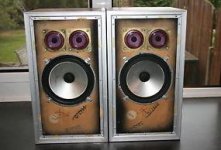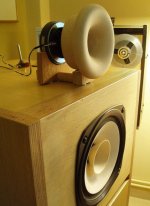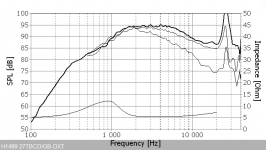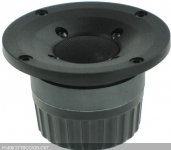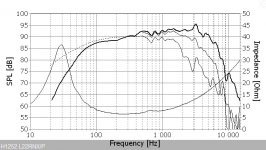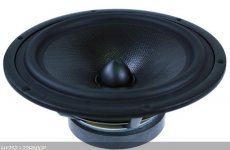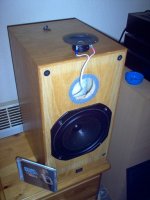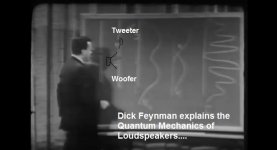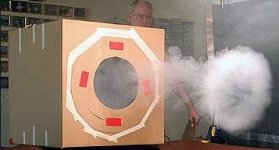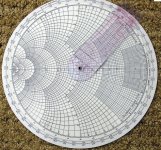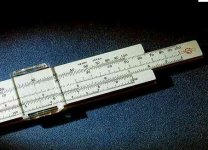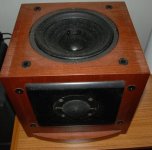Yes, thank you that is what I meant. Also I agree 500Hz would be too low to be practical trying to take this and probably unnecessary as well.
OTOH 440 Hz is in the heart of music, middle C is 261.625565 Hz
reflections are still there and affecting tonal balance - in the heart of music
we are not talking about bass
Musical frequencies can surprise you. They are low. What is Middle C on piano? About 260Hz. Most instruments have no fundamentals above 1kHz. Though, of course, you are hearing much higher 2nd and 3rd harmonics which contribute greatly to the sound and timbre of a Steinway piano, or a National or Fender guitar. See below. 
This is why tweeters aren't actually as important as people make out. Above 3kHz, there is little significant musical output. It's why telephones are quite intelligable on voices, despite not much above 3kHz.
Aren't we going a bit off-topic with this supposed DI aka "Directivity Index"? Of course, dispersion matters. You can hear it. Here's one of my favourite 8" plus 2" speakers:
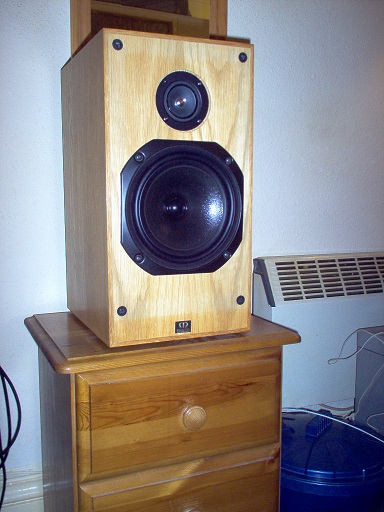
EVERYTHING is wrong with it. Poor dispersion. BW3 power response. But sounds great! Must be doing something right.
I had a look at my guess on the WLM La Scala with a similar driver complement. The shallower low crossover LR2 version has very smooth, but narrowing, directivity. My preferred steeper 3.5kHz BW3 version with a 6kHz notch is a bit rougher. But deals with distortion better, IMO.
So many trade-offs. It's how it works. And being as we all learn as we go along, I can think of even better ways to do this. Driver Impedance correction is a brilliant idea, IMO.
This is why tweeters aren't actually as important as people make out. Above 3kHz, there is little significant musical output. It's why telephones are quite intelligable on voices, despite not much above 3kHz.
Aren't we going a bit off-topic with this supposed DI aka "Directivity Index"? Of course, dispersion matters. You can hear it. Here's one of my favourite 8" plus 2" speakers:
EVERYTHING is wrong with it. Poor dispersion. BW3 power response. But sounds great! Must be doing something right.
I had a look at my guess on the WLM La Scala with a similar driver complement. The shallower low crossover LR2 version has very smooth, but narrowing, directivity. My preferred steeper 3.5kHz BW3 version with a 6kHz notch is a bit rougher. But deals with distortion better, IMO.
So many trade-offs. It's how it works. And being as we all learn as we go along, I can think of even better ways to do this. Driver Impedance correction is a brilliant idea, IMO.
Attachments
-
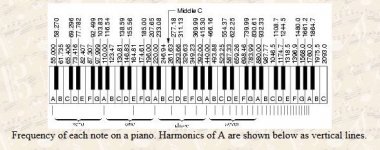 Frequency of piano notes.JPG47.8 KB · Views: 853
Frequency of piano notes.JPG47.8 KB · Views: 853 -
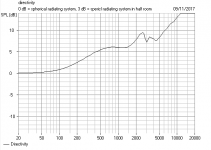 S7 WLM La Scala Higher crossover Parallel.PNG18.4 KB · Views: 61
S7 WLM La Scala Higher crossover Parallel.PNG18.4 KB · Views: 61 -
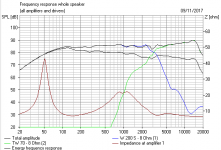 S7 WLM La Scala Parallel notched 6kHz.PNG21.7 KB · Views: 74
S7 WLM La Scala Parallel notched 6kHz.PNG21.7 KB · Views: 74 -
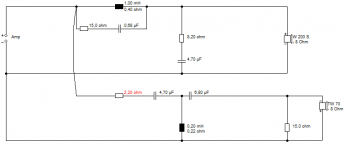 S7 WLM La Scala Parallel notched filter 6kHz.PNG8.4 KB · Views: 70
S7 WLM La Scala Parallel notched filter 6kHz.PNG8.4 KB · Views: 70 -
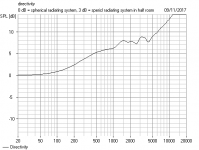 WLM La Scala Low crossover directivity.PNG16.1 KB · Views: 64
WLM La Scala Low crossover directivity.PNG16.1 KB · Views: 64 -
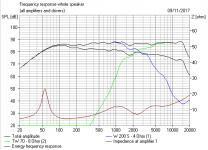 WLM La Scala Series filter.PNG13.3 KB · Views: 267
WLM La Scala Series filter.PNG13.3 KB · Views: 267 -
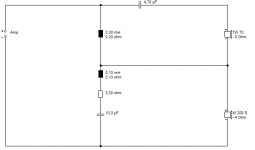 WLM La Scala Series Circuit.PNG5.9 KB · Views: 265
WLM La Scala Series Circuit.PNG5.9 KB · Views: 265 -
 Guitar frequencies Hz.JPG45 KB · Views: 846
Guitar frequencies Hz.JPG45 KB · Views: 846
The shallower low crossover LR2 version has very smooth, but narrowing, directivity. My preferred steeper 3.5kHz BW3 version with a 6kHz notch is a bit rougher. But deals with distortion better, IMO.
...except that neither crossover is really what you claim it is.
If you look at the actual acoustic slopes (which are all that matters), they are all different, and steeper, than the respective 'textbook' LR2 and BW3.
In the second version, for instance, the woofer at 7kHz (one octave above the 3.5kHz crossover point) is down to 50dB, which is 36 dB quieter than the bandpass level of 86dB. This makes the low-pass slope closer to 6th order. And of course the phase response (which isn't shown) must start to nose-dive much sooner and much more rapidly than it would if the crossover were a real BW3.
Pretty much the same story applies to all those other HP and LP slopes too...
That's not to say that those crossovers can't work properly or sound nice. But I think it's a bit disingenuous to refer to them as "LR2" and "BW3" and discuss their pros and cons as if they had anything to do with those 'textbook' slopes.
Cheers,
Marco
I have to admit, marco_gea, that I sometimes simplify the argument to keep our lesser-brethren on board. Is that shameful?
You designed a worthy 2.5kHz LR2 speaker here:
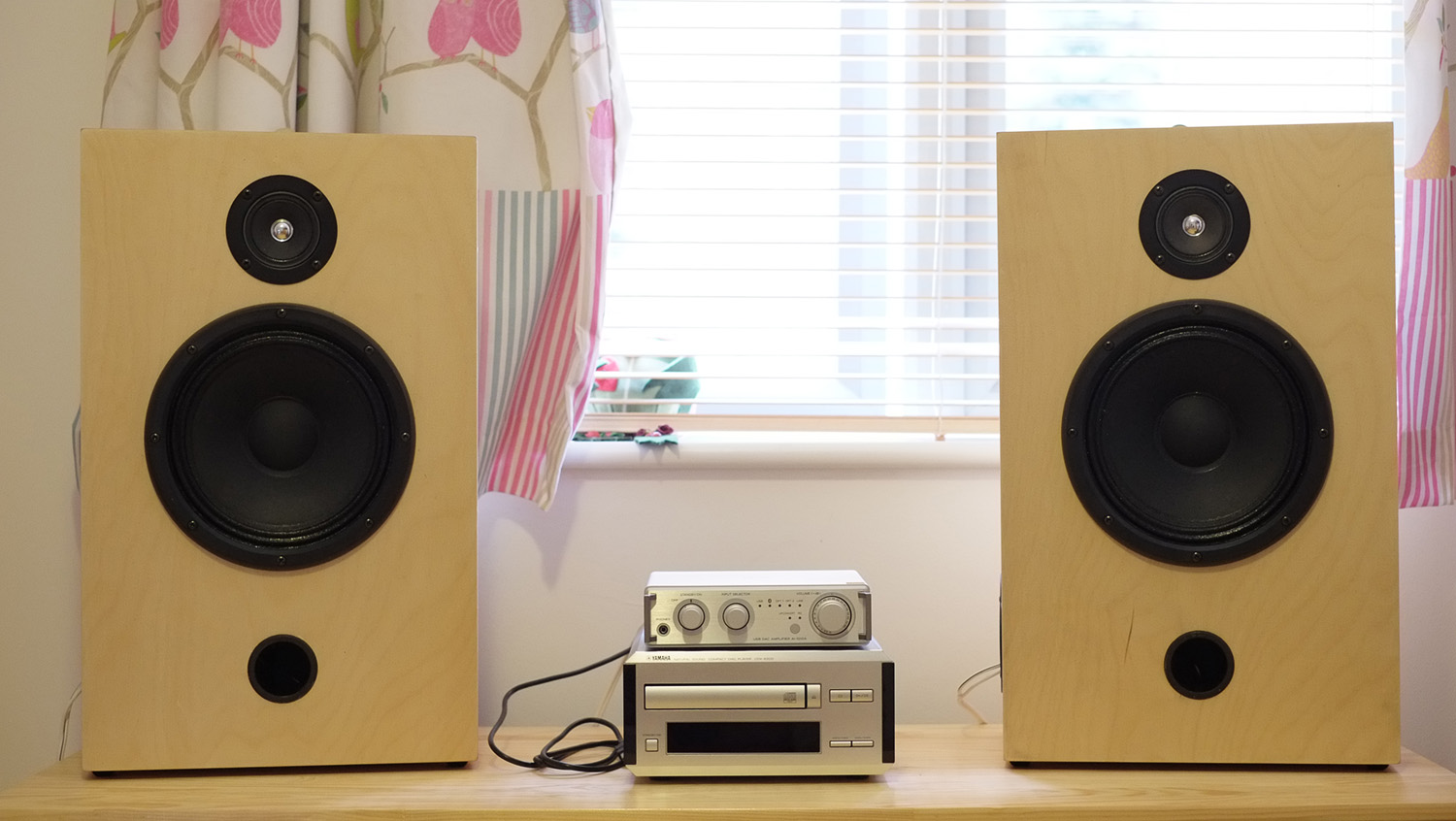
Much to like about that. It's not a million miles away from Henry Kloss's ideas:
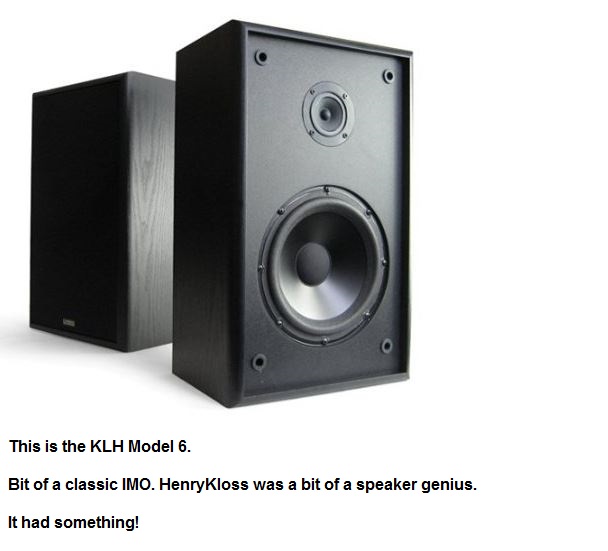
But, TBH, I don't subscribe to the ideas of perfection in Audio. If it was down to me, I might double up the tweeters or woofers for even lower distortion. Henry Leak was also a big noise in Audio. There is much wrong with this idea, IMO. But a lot right.
You designed a worthy 2.5kHz LR2 speaker here:

Much to like about that. It's not a million miles away from Henry Kloss's ideas:

But, TBH, I don't subscribe to the ideas of perfection in Audio. If it was down to me, I might double up the tweeters or woofers for even lower distortion. Henry Leak was also a big noise in Audio. There is much wrong with this idea, IMO. But a lot right.
Attachments
Last edited:
I have found that to get the performers in the room with you, you need to have the band extremes rolled off naturally. Don't ask me to define that, I couldn't. Even a more extended response with a sudden cut-off can be unnatural. I know you can get such a narrow bandwidth to sound balanced if it is dealt right but the reproduction would be obvious.This is why tweeters aren't actually as important as people make out. Above 3kHz, there is little significant musical output. It's why telephones are quite intelligable on voices, despite not much above 3kHz.
I have to admit, marco_gea, that I sometimes simplify the argument to keep our lesser-brethren on board. Is that shameful?
Of course not! And sorry if I came across a bit snarky - that wasn't intended.
I just wanted to point out that real-world crossovers rarely - if ever - conform to any 'textbook' recipes.
Thanks! Though I wouldn't describe that as "LR2" either.You designed a worthy 2.5kHz LR2 speaker here:

Much to like about that.
2nd order electrical? sure - but "Linkwitz-Riley" acoustical? Not really!
It's not a million miles away from Henry Kloss's ideas:

Sure, it looks similar enough.
But, TBH, I don't subscribe to the ideas of perfection in Audio. If it was down to me, I might double up the tweeters or woofers for even lower distortion. Henry Leak was also a big noise in Audio. There is much wrong with this idea, IMO. But a lot right.
I actually agree with most of what you say.
And of course, absolute perfection is not - and likely will never be - achievable.
At the same time, though, and as nice as the little system that I designed above does sound in its own right, I can assure you that it absolutely sounds like a broken toy when directly compared to THIS other system that I also designed and built:
An externally hosted image should be here but it was not working when we last tested it.
Of course, the latter was also over TWENTY times as costly to put together... the law of diminishing (economic) returns!
But what is 'good enough' is not set in stone, and in the end not everyone is as easily pleased.
Amicably,
Marco
Musical frequencies can surprise you. They are low. What is Middle C on piano? About 260Hz. Most instruments have no fundamentals above 1kHz. Though, of course, you are hearing much higher 2nd and 3rd harmonics which contribute greatly to the sound and timbre of a Steinway piano, or a National or Fender guitar. See below.
This is why tweeters aren't actually as important as people make out. Above 3kHz, there is little significant musical output. It's why telephones are quite intelligable on voices, despite not much above 3kHz.
According to Griesinger we detect pitch more on the higher harmonics than we do on the fundamental. This is why if you delete the fundamental your brain will still hear the same pitch. It will fill in the fundamental. It's the relationship between the harmonics that matters most, not the fundamental.
Dr. Griesinger claims that 700 - 7000 is the critical range of frequencies for good sound quality, and I tend to agree with that.
In my system the "tweeter" goes down to about 800 Hz and so the tweeter is covering virtually the entire critical range all by itself. How can you then say that "tweeters aren't actually as important as people make out."
Don't make broad brushed statements when they only apply to the way you do things. Yes if your tweeter only covers 3 kHz and above it isn't a big contributor, but that's why I would never do that. I try and get the crossover as low as possible and that cannot be done with a dome tweeter.
Last edited:
I have to admit that I am not a great TEAM PLAYER. 
I am the 1 in 3 who is an individualist: Susan Cain: Leading the “Quiet Revolution”
I am happiest doing my own thing, free of peer pressure. There are others in the same mold who did useful work: Einstein tensor - Wikipedia.
One of our forum treasures is Joachim Gerhard. I have heard some of Joachim's speakers, liked a few, criticised a few, but always interesting:
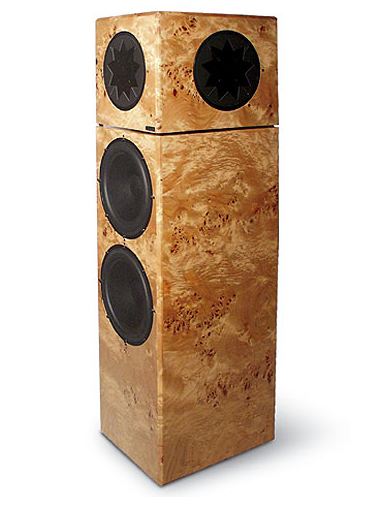
This is a narrow-directivity Mangar (near fullrange) design with Scan woofers to fill in the bottom end. It's extraordinary. Honestly. I've never heard a speaker that can compare with what it does.
I'll try and contain myself here, and just comment on what Joachim is up to right now. He's using these two SEAS drivers on a cap and coil filter. A lot to like there IMO. AllenB will get this.
I'll save toroids, pseudospheres and even 10D phase space for another day. Oh heck, lastly, here's a near fullrange tractrix design to enjoy.
I am the 1 in 3 who is an individualist: Susan Cain: Leading the “Quiet Revolution”
I am happiest doing my own thing, free of peer pressure. There are others in the same mold who did useful work: Einstein tensor - Wikipedia.
One of our forum treasures is Joachim Gerhard. I have heard some of Joachim's speakers, liked a few, criticised a few, but always interesting:
This is a narrow-directivity Mangar (near fullrange) design with Scan woofers to fill in the bottom end. It's extraordinary. Honestly. I've never heard a speaker that can compare with what it does.
I'll try and contain myself here, and just comment on what Joachim is up to right now. He's using these two SEAS drivers on a cap and coil filter. A lot to like there IMO. AllenB will get this.
I'll save toroids, pseudospheres and even 10D phase space for another day. Oh heck, lastly, here's a near fullrange tractrix design to enjoy.
Attachments
Earl, you are tremendously aggressive. First you try to lure me into saying that RCL filters are non-linear, which of course they aren't. The whole topic is LINEAR signal processing.According to Griesinger we detect pitch more on the higher harmonics than we do on the fundamental. This is why if you delete the fundamental your brain will still hear the same pitch. It will fill in the fundamental. It's the relationship between the harmonics that matters most, not the fundamental.
Dr. Griesinger claims that 700 - 7000 is the critical range of frequencies for good sound quality, and I tend to agree with that.
In my system the "tweeter" goes down to about 800 Hz and so the tweeter is covering virtually the entire critical range all by itself. How can you then say that "tweeters aren't actually as important as people make out."
Don't make broad brushed statements when they only apply to the way you do things. Yes if your tweeter only covers 3 kHz and above it isn't a big contributor, but that's why I would never do that. I try and get the crossover as low as possible and that cannot be done with a dome tweeter.
Now you try to poo poo my idea that above 3kHz, there isn't much information. I don't care what YOU do in your esoteric horn designs. It's what most of us here do that matters.
And, FWIW, I am perfectly familiar with the idea that the brain can hear the harmonics and fill in the fundamental note. It's why small speakers can sound bassy.
With your approach, we'll never get anywhere. Here's what I did with one of my BW3 designs. And, TBH,, I was more interested in testing the idea that 90 degree BW3 phase might equate to 90 degree alignment. It actually sounded quite good in the Sonab omni style. All the >3kHz tweeter did was add a bit of air when you took your hand off it!
Attachments
system7 said:Now you try to poo poo my idea that above 3kHz, there isn't much information.
gedlee said:Yes if your tweeter only covers 3 kHz and above it isn't a big contributor
Actually, to me it seems as if on this particular point there is good agreement.
The disagreement - instead - is on whether it's a good idea to cross over at 3kHz in the first place.
Honestly, based on my own experience, I tend to side with Dr. Geddes on this latter point. And sorry, but just because "most of us here" do it, doesn't make it the best idea.
After all, "most people" are happy listening to music on their PC speakers and crappy earpods - by the same logic, does that entail that one shouldn't argue that there are better ways to do it?
Sorry, system7, I often like your posts, but this one in particular came across as unnecessarily defensive to me.
Marco
TBH, I don't care where you crossover. The Universe seems to know you are doing it. 
It's the Quantum Theory. Exemplified by one of my Physics heroes, Dick Feynman. Below. Now, TBH, it's quite hard to find Planck's constant in loudspeakers. But the diffraction maths seems to apply anyway.
Let's get back to this extraordinary Manger speaker by Joachim Gerhard:

I have really no idea what exactly Joachim was doing here. But I've never heard a speaker like it. Why did he add sideways facing drivers to the narrow-directivity Manger idea? Obviously, taking the bass load out of the equation was a sensible idea. Excursion equals distortion. Because speakers are non-linear in the end.
This, BTW, is a £25,000 speaker. No compromise. I couldn't afford it myself. But my friends can. And you have to listen to it exactly on-axis, where it resembles headphones. Joachim Gerhard is a tremendously bright guy, IMO.
It's the Quantum Theory. Exemplified by one of my Physics heroes, Dick Feynman. Below. Now, TBH, it's quite hard to find Planck's constant in loudspeakers. But the diffraction maths seems to apply anyway.
Let's get back to this extraordinary Manger speaker by Joachim Gerhard:
I have really no idea what exactly Joachim was doing here. But I've never heard a speaker like it. Why did he add sideways facing drivers to the narrow-directivity Manger idea? Obviously, taking the bass load out of the equation was a sensible idea. Excursion equals distortion. Because speakers are non-linear in the end.
This, BTW, is a £25,000 speaker. No compromise. I couldn't afford it myself. But my friends can. And you have to listen to it exactly on-axis, where it resembles headphones. Joachim Gerhard is a tremendously bright guy, IMO.
Attachments
TBH, I don't care where you crossover. The Universe seems to know you are doing it.
It's the Quantum Theory. Exemplified by one of my Physics heroes, Dick Feynman. Below. Now, TBH, it's quite hard to find Planck's constant in loudspeakers. But the diffraction maths seems to apply anyway.
TBH, you lost me there.
I fail to see how Quantum Theory has anything to do to where to best crossover a woofer and a tweeter, from a psychoacoustics perspective.
(And incidentally, it's not just because the words "quantum theory" scare me. I studied a fair bit of it myself, as I happen to have a PhD in chemical sciences)
Excursion equals distortion. Because speakers are non-linear in the end.
100% agreed there.
Marco
TBH, the Quantum Theory is a bit beyond my own abilities too.
But I still enjoy it, because it is provably right over the classical theory. I think this is down to Sidney Coleman: YouTube.
Not quite Dick Feynman in my estimation, but a leading light. Sorry about the poor quality, BTW.
Interestingly, Sidney Coleman was interested in the idea of M + jT and M - jT. I am using the engineer's j version of the complex number i here. We do this to distinguish it from I which is current in engineering.
This is an ideas thread. We all need a good idea. I got interested in whether j actually represents 90 degree phase or 90 degree physical direction.
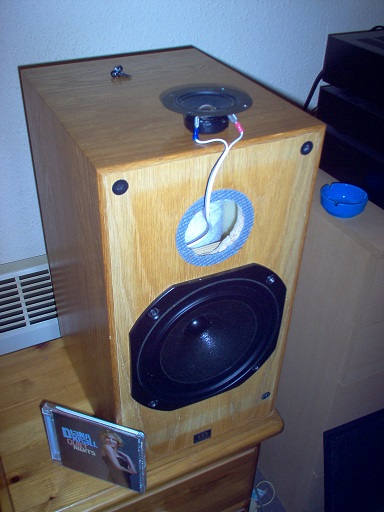
Maybe it's debatable. IMO, 180 degrees phase might mean you point one of the drivers backwards. And it might sound much the same once it's bounced off the wall. I really don't know. I assume NOTHING about the Universe.
But I still enjoy it, because it is provably right over the classical theory. I think this is down to Sidney Coleman: YouTube.
Not quite Dick Feynman in my estimation, but a leading light. Sorry about the poor quality, BTW.
Interestingly, Sidney Coleman was interested in the idea of M + jT and M - jT. I am using the engineer's j version of the complex number i here. We do this to distinguish it from I which is current in engineering.
This is an ideas thread. We all need a good idea. I got interested in whether j actually represents 90 degree phase or 90 degree physical direction.
Maybe it's debatable. IMO, 180 degrees phase might mean you point one of the drivers backwards. And it might sound much the same once it's bounced off the wall. I really don't know. I assume NOTHING about the Universe.
Last edited:
--
This is an ideas thread. We all need a good idea. I got interested in whether j actually represents 90 degree phase or 90 degree physical direction.

Maybe it's debatable. IMO, 180 degrees phase might mean you point one of the drivers backwards. And it might sound much the same once it's bounced off the wall. I really don't know. I assume NOTHING about the Universe.
Front wall reflection is totally different, it has delay.
180 phase shift means that you have to rotate the "upper" driver, or more likely to wire it in negative polarity. This thinking is a bit complicated, because at crossover region both upper and lower driver have phase shift in opposite directions. They sum flat SPL, but phase gradually turns 180¤ This can be measued if we compare phase angle before LP and after HP begin to have an effect. This means 2 octaves apart with LR2!
An example from Troels OBL11
Last edited:
Earl, you are tremendously aggressive. First you try to lure me into saying that RCL filters are non-linear, which of course they aren't. The whole topic is LINEAR signal processing.
Now you try to poo poo my idea that above 3kHz, there isn't much information. I don't care what YOU do in your esoteric horn designs. It's what most of us here do that matters.
Yes, I will aggressively go after false or misleading statements, like yours about filters being nonlinear. All you have to say is "Sorry, I misspoke, I did not mean to imply that they are nonlinear."
I misspeak all the time and when called out I try to clear things up. No one never makes mistakes and it's important to keep the record factual. Otherwise audio will continue to wander into the never-never land of audiofoolery.
And you must not have read what I said because I agree that if all your tweeter does is > 3kHz then its not so important, but many people don't do things that way.
Keep to the facts and stay away from subjective based hypothesizing (and maybe irrelevant references to quantum mechanics) and we'll be just fine.
Last edited:
As someone who has been in this hobby for 50 years now, and stopped to get an electrical engineering degree somewhere along the way, I am greatly amused by some of the arguments on these boards and those who believe that engineering is actually ruled by inviolable concepts and theories. The absolute best definition of engineering I have ever come across is “the art of figuring out which parameters can be safely ignored.”On another thread someone wrote something to the effect that those who crossed over at or above 3 KHz ignoring the directivity index were fools who had no idea what they were doing.
That comment made me draw up a short list of fools who did not know what they were doing and whose speakers must have had terrible midrange.
Lighten up guys. None of us have absolute answers.
I apologize to any other fools I neglected to mention.
That comment made me draw up a short list of fools who did not know what they were doing and whose speakers must have had terrible midrange.
- The entire BBC team who thought 8” drivers could be crossed over at 3 KHz in their monitors.
- Spendor, from the original BC1 (8”) to the current D7 (7”) crossing at 3 KHz
- Harbeth who still think you can cross 8” woofers at 3 KHz.
- Bowers and Wilkins who still think you can cross 6” drivers at 4 KHz in their flagship 800 series.
- Aerial Acoustics who take an SB 5” Papyrus mid to 3KHz in their 7T
- Sony with their SS-AR1 who think that they can take a Scan 15M Revelator from 400 to 4 KHz
- The biggest fool had to be Peter Walker of Quad who thought you could take a wide flat panel to 7 KHz before crossing to a narrow strip
Lighten up guys. None of us have absolute answers.
I apologize to any other fools I neglected to mention.
Juhazi, I think my idea that 90 or 180 degrees has a physical as well as a phase interpretation is just terribly clever. But not actually original because Roy Allison did this stuff years back, see below.

And it's not inconceivable that Joachim Gerhard, who knows a thing or two about BW3, might have been doing something like it here, because sideways facing drivers can fill a crossover power hole in a room even if you don't hear them directly:

And don't forget that a speaker is usually a dipole, which is a game changer to the thought experiment.
But, thankyou, Fernando. I too have a great time crossing an 8" to a 2" at 3kHz, but TBH, I am increasingly preferring steeper filters with this slightly difficult combination:

It took me years to understand why it is actually very BBC and all done 50 years ago with engineers with slide rules (logarithms) and Smith charts (circle preserving conformal transformations) to do the computing: Rogers Loudspeakers › LS5/9
Negative polarity on a bass unit with terrible time-alignment problems! Makes it all work! And we know (because I showed you...) that group delay on the musical information is not affected by polarity. That plus the currently almost ignored BW3 90 degree phase idea which fills the power hole (in the room acoustic) of a (modern... ) 6db crossover phase-aligned LR2 or LR4 crossover.
) 6db crossover phase-aligned LR2 or LR4 crossover.
IMO, I very rarely talk nonsense. I do simplify on occasion for brevity. Nobody reads the long posts.
Increasing, as an old timer in this game, I just shoot the breeze and trust my muse. And I have definite opinions of what works well and I test them, because, Earl, a point in every direction is no point at all. We should beware of being negative and critical. It's a VERY BAD THING! For all I know, your speakers may just be blowing smoke-rings. Prove to me they are not! The Four States of Mind
I'll shut up now. But do keep the ideas coming. I want to hear yours!
And it's not inconceivable that Joachim Gerhard, who knows a thing or two about BW3, might have been doing something like it here, because sideways facing drivers can fill a crossover power hole in a room even if you don't hear them directly:
And don't forget that a speaker is usually a dipole, which is a game changer to the thought experiment.
But, thankyou, Fernando. I too have a great time crossing an 8" to a 2" at 3kHz, but TBH, I am increasingly preferring steeper filters with this slightly difficult combination:
It took me years to understand why it is actually very BBC and all done 50 years ago with engineers with slide rules (logarithms) and Smith charts (circle preserving conformal transformations) to do the computing: Rogers Loudspeakers › LS5/9
Negative polarity on a bass unit with terrible time-alignment problems! Makes it all work! And we know (because I showed you...) that group delay on the musical information is not affected by polarity. That plus the currently almost ignored BW3 90 degree phase idea which fills the power hole (in the room acoustic) of a (modern...
IMO, I very rarely talk nonsense. I do simplify on occasion for brevity. Nobody reads the long posts.
Increasing, as an old timer in this game, I just shoot the breeze and trust my muse. And I have definite opinions of what works well and I test them, because, Earl, a point in every direction is no point at all. We should beware of being negative and critical. It's a VERY BAD THING! For all I know, your speakers may just be blowing smoke-rings. Prove to me they are not! The Four States of Mind
I'll shut up now. But do keep the ideas coming. I want to hear yours!
Attachments
Last edited:
And I have definite opinions of what works well and I test them, because, Earl, a point in every direction is no point at all. We should beware of being negative and critical. It's a VERY BAD THING! For all I know, your speakers may just be blowing smoke-rings. Prove to me they are not!
Steve
None of my comments to you have been about my speakers or how I designed them. They were simply pointing out errors or serious limitations in your comments. This is not a contest of speaker designs.
That said. I have always offered proof of what I claim in the form of a database of extensive polar measurements on dozens of loudspeakers of a variety of designs so that people could look and judge for themselves.
As you may or may not know I no longer make speakers, I don't do any acoustic designs of any kind anymore so I have no "dog in this race" so to speak. I do have 50+ years of education, research and experience in this area however and I will always use that to try and bring some sanity into audio.
- Status
- This old topic is closed. If you want to reopen this topic, contact a moderator using the "Report Post" button.
- Home
- Loudspeakers
- Multi-Way
- Well I suppose the shallow vs. steep argument will just go on and on
